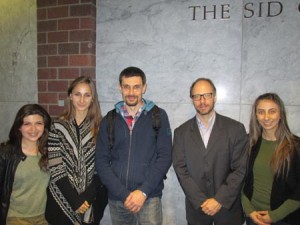Emma Shaljyan
Staff Writer

Photo: Barlow Der Mugrdechian
Dr. Arsen Saparov, visiting lecturer at the University of Michigan, Ann Arbor, was the guest of the Armenia Studies Program on Friday, November 15, speaking on the topic of “Drawing Borders in the Caucasus-the Early 1920’s.” Dr. Saparov earned his Ph.D. from the London School of Economics, where his research focused on the issue of the creation of autonomous regions by the Soviet Union in the 1920s.
The lecture was the first in a two-part presentation on “Karabagh: An Historical Perspective,” with the second presentation by Dr. Ara Sanjian (University of Michigan-Dearborn), on “Irredentism at the Crossroads of Nationalism, Communism and Diverging Interpretations of the Soviet Experience: The Armenian Diasporan Press on Mountainous Karabagh, 1923-1985.”
Dr. Saparov started his lecture with an analysis of the historical status of Karabagh in 1921 and how that status was determined. He discussed four Soviet decisions taken between November 30, 1920 and July 4, 1921 on the Karabagh issue, all without exception deeming that Karabagh should be administered by Soviet Armenia. Ultimately however, Nagorno-Karabagh was granted the status of an autonomous region, but under the jurisdiction of Soviet Azerbaijan. The process of how this decision was made was the focus of Dr. Saparov’s presentation.
The declarations of independence of Armenia, Georgia, and Azerbaijan in 1918 did not mention territorial boundaries, which led to disputes over the regions of Zangezur, Nakhichevan, and Karabagh. By 1921, the Russian communists had taken over Armenia, Georgia, and Azerbaijan. The Bolsheviks saw regions such as Karabagh as a means to communicate with Kemalist Turkey, which whom the Bolsheviks shared common enemies.
Dr. Saparov concluded that the Soviets were trying to resolve, rather than to manipulate, further conflicts. He identified a pattern that emerged in the disputed regions—whoever first controlled these territories would retain control under Soviet rule. The effect of these decisions made nearly one hundred years ago, are still a source for discussion today.
Dr. Ara Sanjian’s presentation sought to give an overview of how Armenians viewed the Karabagh issue in the Diasporan press, between the years 1923-1985. Due to illness Dr. Sanjian was not present at the lecture, but his paper was read by Dr. Sergio La Porta of the Armenian Studies Program.
In his paper Dr. Sanjian compared how the issue of Karabagh was raised in the newspapers of the three major Armenian political parties: the Dashnaks, the Hunchaks, and the Ramgavars. There were numerous polemics in the press on how demands for return of Karabagh should be pursued. In the 1960’s, the issue of “Karabagh and ‘internal lands’ was raised in the Armenian press, especially in Lebanon.
Dr. Sanjian’s research delineated the various themes in the Armenian press regarding the Karabagh issue, including arguments that “these lands were historically Armenian,” and “Soviet Armenia should have full republican sovereignty over these issues.” It was interesting to see the various shades of responses by the newspapers.
The attitudes of the three Armenian political parties differed towards the communist authorities and even changed as circumstances changed within Soviet Armenia. However, in the period 1953-1985, none of the articles dealing with the ‘internal lands’ foresaw the dissolution of the Soviet Union.
Dr. Sanjian’s presentation gave a new perspective to the Karabagh issue as seen through the eyes of Diasporan Armenians and the press.
 Hye Sharzhoom Armenian Action
Hye Sharzhoom Armenian Action